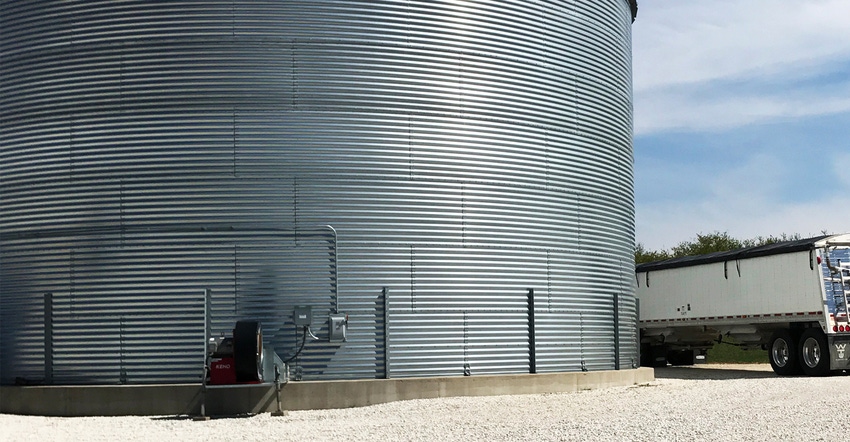May 21, 2020

Farmers are choosing to store their grain longer this year due to low commodity prices. Last fall’s harvest was wetter than average, and corn and soybeans in bins already have high moisture levels. Waiting for prices to increase could result in damaged products.
Matthew Willimack, farm marketer for Cargill, buys grain from producers and helps navigate them through risk management decisions. Farmers across Iowa are experiencing low prices for corn and soybeans primarily because of the coronavirus.
“You have very weak demand in the ethanol sector due to significantly less miles being driven,” Willimack says. “Feed demand is also being affected. With restaurants closed, we are seeing a different type of demand for meat and protein. Producers are feeding different rations because of it.”
While there is less of a demand for grain domestically, there are also global factors that play into low prices. South America is producing large volumes of soybeans, which are exceeding global demand.
John Greiner is a merchandiser for Kat’s Grain Inc. at Washington in southeast Iowa. In addition to economic issues related to the coronavirus, Greiner says markets are down because of USDA’s planting intentions estimates for the present crop year.
“USDA estimated we are going to plant 97 million acres of corn,” Greiner says. “If that’s not a record, it’s very close. Last year we planted 90 million. If we take on 7 million more acres, we are going to add 1.25 billion bushels to the supply.”
Higher moisture content
If farmers have the financial stability to store their grain longer, Willimack says some will do so in hopes of prices increasing. Considering last year’s harvest was wetter than normal, stored grain is at a higher risk to spoil.
“Grain quality was less ideal when harvested,” Willimack says. “Due to higher moisture content, the corn had more broken kernels and also a lower test weight. These factors affect the storability of grain.” A lower test weight in corn correlates to a lower quality and strength of the kernel. As heat and moisture in a bin increase, weakened kernels are more susceptible to damage and mold.
To reduce the risk of spoilage, farmers are advised to keep corn moisture below 15% and soybeans below 13% while in storage. There are steps a farmer can take to try to control grain moisture inside grain bins.
“One of the first lines of defense is to properly dry the grain,” Willimack says. “Next, many farmers have fans on their bins that can control airflow. Lastly, continually moving grain by coring the center of a bin where smaller particles reside also helps.”
Selling rather than holding
It might be in farmers’ best interest to sell their grain anyway despite attempts to reduce moisture levels. If there is a 17% moisture content or higher in a bin, Greiner suggests selling the grain now. Once grain is damaged, a farmer will have a hard time getting rid of it.
“We’ve got cattle producers in the area offering $1.80 per bushel, but any hog producers or grain processors will not dump a truck if it’s over 20% damaged,” he says. “You can’t grind damaged corn into feed because it will leave an odor. You can’t put that feed in front of a sow because she will back off of it.”
Greiner has seen damaged grain coming from farms within the past few months and expects to see more of it in the future as temperatures increase into summer. “I have a feeling it’s going to get worse,” he says. “We haven’t seen a lot of warm weather yet, and a lot of times that’s what really kick-starts the process where bins tend to go bad. We will see more damaged corn than usual this summer; I’m very confident of that.”
Charles Hurburgh, director of the Iowa Grain Quality Initiative at Iowa State University, advises farmers to move out their low-quality grain now. If the grain quality is OK but it’s higher moisture content, dry it down to a safe moisture level for continued storage.
However, with the combination of low prices and low demand, and the continued COVID-driven lower demand projected for the 2020 crop, “this situation is likely to create a shortage of storage space for crops this fall,” he says. “Especially if you see an opportunity to catch a price rally to move stored grain, be ready to start emptying bins and get your on-farm storage space ready for the new crop.”
It is reasonable to predict a high-yielding harvest this fall. “We have ideal planting conditions, so we are on the way to a good crop already,” Hurburgh says. “The more weather conditions stay favorable, the more grain we are going to expect.”
As farmers decide to sell or store their grain from last year, Hurburgh says they should think about their crop from this year as well. “If you’ve never made choices as to what grain to store and what grain to sell, expect to do so now,” he adds. A piece of advice is knowing your product’s potential test weight. “It’s a good idea to know which ones are likely to have higher test weights. Those would be good candidates to store for a longer period of time.”
For information on stored grain management, visit the Iowa Grain Quality Initiative website.
Friedrichsen is a Wallace’s Farmer summer intern.
You May Also Like




